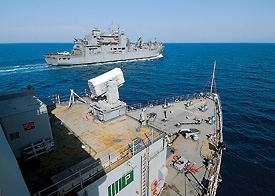Educating and developing the next generation of world-class naval systems engineers is the goal of a new Naval Engineering Education Center (NEEC) to be led by U-M.
The center was established through a $3.2 million contract award from the Naval Sea Systems Command (NAVSEA). The contract includes five additional years of optional extensions that could add up to $49.9 million.

The Military Sealift Command dry cargo and ammunition ship USNS Robert E. Peary (T-AKE 5) pulls away from the amphibious dock landing ship USS Ashland (LSD 48) after conducting a replenishment at sea. Photo courtesy U.S. Navy.
“It is a privilege for Michigan Engineering to lead this ground-breaking program, which is among the largest in the history of the college,” says David Munson, the Robert J. Vlasic Dean of Engineering. “We look forward to creating enormous value for both the Navy and our students.
“With the ‘peace dividend’ associated with the end of the Cold War, the U.S. Navy experienced a significant reduction in its ship design capability. And the remaining ship design workforce is aging,” Munson says. “The NEEC will supply a large number of uniquely educated students to the Navy to help rebuild its design expertise. Participation in this program will provide outstanding learning opportunities for students from Michigan and from our partner universities.”
Fifteen top colleges and universities from across the country will make up the consortium, along with the American Society of Naval Engineers and the Society of Naval Architects and Engineering. The purpose of the NEEC will be to educate and develop world-class naval systems engineers for the Navy’s civilian engineering, acquisition and science workforce.
“The NEEC will provide NAVSEA a pipeline of engineers in critical engineering career fields to address the challenges we face in building and sustaining the 21st century Navy,” says Brian Persons, executive director of NAVSEA. “This is a huge step to help address Navy research and engineering development needs and challenges. It is the newest tool in NAVSEA’s talent management strategy to develop, attract and retain the broader more capable workforce.”
The NEEC consortium will help increase the number of students who graduate with an accredited degree through:
• Recruiting and retaining world-class faculty specialized in naval engineering;
• Coordinating employee development opportunities to retain naval engineering talent for the Navy; and
• Increasing the availability of naval engineering education programs and courses across universities and colleges.
A key part of the NEEC is using project-based education to provide actual naval engineering experience to students. NEEC project teams from the universities along with a NAVSEA engineer or scientist assigned to the team will tackle current and future technical challenges including the use of alterative energy sources, energy conservation, reduction in total ownership costs, use of unmanned vehicles, advanced ship design methods and reduction in maintenance. Through NAVSEA internships and at-sea opportunities on US Navy ships, students will receive relevant hands-on naval engineering experience. Additionally, the NEEC universities will partner with the American Society of Naval Engineers and the Society of Naval Architects and Engineering to develop a robust program for K-12 outreach to increase a student pipeline across the nation interested in pursuing education in science, technology, engineering and math.
“We are very pleased that so many members of the naval engineering community have come together in this effort, says NEEC Director Steven Ceccio, a professor in the Department of Mechanical Engineering, and the Department of Naval Architecture and Marine Engineering. “Michigan has a long and proud tradition in education and research in support of the Navy, and we are proud to have this opportunity to lead the NEEC. We look forward to working with all our partners as we develop the next generation of naval engineers.”

